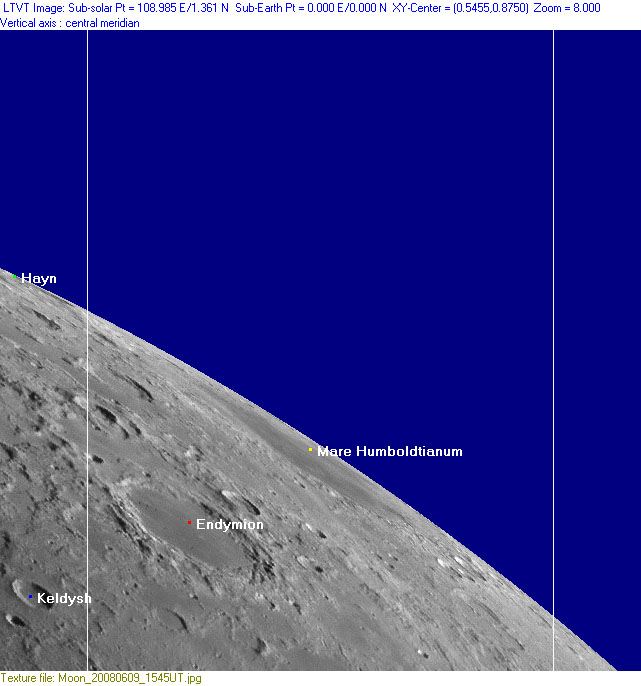Rükl 7
Contents
Rükl Zone 7 - ENDYMION
Neighboring maps on the Rükl Nearside Map:
| 7 |
||
Photographic Map
(This map is based on an Earth-based photograph that has been computer-corrected to zero libration. The vertical white lines indicate the left and right boundaries of the Rükl rectangle)
Background image source
Nearside Named Features
- Ancient crater between Endymion and De La Rue (see SLC map B1).
- Andes mountains and Bishop mountains (C.A.Wood's unofficial names for the inner and outer rings of Mare Humboldtianum).
- Atlas P, an irregular "crater" east-northeast of Atlas itself (northwest of Lacus Temporis) has a pronounced hill on the eastern part of its rim. According to SLC map B1, that hill received the Greek letter designation Epsilon (Atlas Epsilon?). See SLC-B1 (System of Lunar Craters, 1966).
- Endymion (Van Langren's Endymionis, J.Hewelcke's Lacus Hyperboreus Superior) (note: Endymion is one of Van Langren's very few names which are still anchored at their original location).
- Endymion's concentric crater (a nickname from D.Caes for the concentric crater southwest of Endymion).
- Endymion's triplet (a nickname from D.Caes for the curious row of three craterlets on the floor of Endymion, which seems to have been discovered by Major Molesworth in 1894, see page 159 of T.W.Webb's Celestial Objects for Common Telescopes, Volume 1: The Solar System).
- Fredericos (F.C.Lamech's disallowed name for Endymion A).
- Hayn-Bel'kovich shadow (an unofficial name from D.Caes for a curious clair-obscur phenomenon near Hayn and Bel'kovich, see Additional Information below).
- Lacus Temporis (a small section of the northern part of it, depicted at the central part of the lower margin of Chart 7).
- L.F.Ball (a disallowed name from H.P.Wilkins for Endymion B).
- Linea Mercurius (an unofficial name from B.Arnett, see Additional Information below).
- Mare Humboldtianum (Van Langren's Pappi, J.Hewelcke's Palus Amadoca, Riccioli's Zoroaster).
- Regiomontani (Van Langren's disallowed name for Endymion C).
- Terra Honoris/ Terra Sapientiae (two of Van Langren's disallowed names for the north-northeastern limb regions, it is not known if Mare Humboldtianum (Van Langren's Pappi) was included in Terra Honoris or Terra Sapientiae).
- Terra Vitae (Riccioli's discontinued name for the region on the whole of Chart 7).
Farside Named Features
(The following features are not formally included in the present Rükl rectangle, but they are adjacent to it and their centers are less than 10° beyond the mean limb -- so they may be seen here in whole or in part with a favorable libration)
- Bel'kovich (see clair-obscur phenomenon described below).
- Compton
- Compton-Bel'kovich Volcanic Complex (informal name, also known as CBVC).
Lettered Crater Locations
(click on the thumbnails to display full-sized images; use browser BACK button to return - the dashed white lines are the midpoints of the Rükl zones)
Full zone with lettered craters:
Lettered craters by quadrants:
| South West |
South East |
Additional Information
- Other online descriptions of features in this Rükl map section:
Linea Mercurius
Seems to be an unofficial name from moonobserver Bill Arnett for a curious formation near crater Mercurius. I have to investigate this, because I don't know the pinpoint location of it, nor its dimensions... - DannyCaes Oct 2, 2015
The Hayn-Bel'kovich shadow: a curious clair-obscur phenomenon
This is the region of the curious clair-obscur phenomenon Hayn-Bel'kovich shadow, always observable one or two days before Full Moon, when the morning terminator is close to the western limb, but... it's a wrong shadow because its appearance is too soon, it should be visible about one or two days AFTER Full Moon!
- DannyCaes Sep 12, 2015



